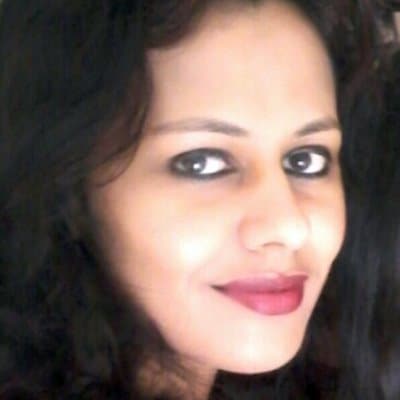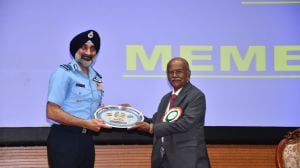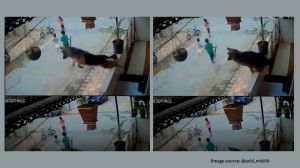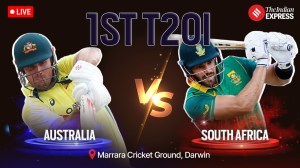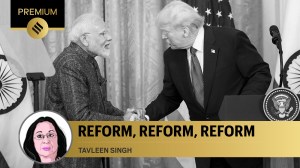Chandigarh reels under traffic; war over Metro on for five years
The war over Metro has been going on for the last five years. While Member of Parliament Kirron Kher has strongly opposed the Metro project, Bansal and BJP leader Satya Pal Jain have taken a favourable stand against the Metro.
 The daily commute is a huge issue in the Tricity, with Chandigarh alone seeing an addition of 124 new vehicles to its roads every day. (Express)
The daily commute is a huge issue in the Tricity, with Chandigarh alone seeing an addition of 124 new vehicles to its roads every day. (Express)
Minutes after his name was announced as the Congress candidate from Chandigarh for upcoming Lok Sabha elections Tuesday evening, Former Railway Minister and four-time city MP Pawan Bansal said reviving the project of Metro will be his priority.
The war over Metro has been going on for the last five years. While Member of Parliament Kirron Kher has strongly opposed the Metro project, Bansal and BJP leader Satya Pal Jain have taken a favourable stand against the Metro.
With Chandigarh adding around 300 vehicles every month, traffic jams across city is a common sight. An effective public transport is the need of the hour.
In 2017, Home Minister Rajnath Singh had asked the UT Administration to look for alternative modes of transport other than Metro as the officials had cited non-feasibility of the project in city.
However, in the recent meeting of Administrator’s Advisory council, the issue of Metro was again raised with Congress leader Pawan Bansal and BJP leader Satya Pal Jain lending their support to the project, while Kher demanded a Monorail instead.
Most of the members of the council stated that if fund crunch was a problem, let all four states- Punjab, Haryana, Himachal Pradesh and the Union Territory – share the cost of the metro.
However, while supporting the monorail, Kher said, “Punjab and Haryana can use the metro up to Chandigarh and then transfer to monorail as that will save the city from being dug up.”
Vinod Vashisht, Convener of City Forum of Residents’ Welfare Organisations(CFORWO) , said, “We will be able to reduce the use of personal vehicles only if we have a good public transport that provides end-to-end connectivity to one’s destinations. I feel Tricity needs a mix of three-tier mass rapid rail transit system- one which is monorail covering phase 1, then a circular elevated monorail twin-line (clockwise and anticlockwise) that can be built covering Phase 2, 3 junction sectors of Chandigarh- ISBT in Sector 43, district courts in Sector 43, the lake in Sector 42, PU west, PGI northwest, Civil Secretariat, High Court, IT Park, Industrial Area and GMCH-32.”
The initial plan
The Union Ministry of Urban Development decided to provide 50 per cent funds for development of Metro, while the rest of the cost was to be borne by the UT. Though the work on first phase of project was scheduled to begin from 2013, due to the delay, the cost of the project escalated. The estimated cost of the project jumped from Rs 10,900 crore to Rs 13,600 crore.
It was stated that Greater Chandigarh Transport Corporation (GCTC) will be formed, following which the work will be started. The Rail India Technical and Economic Service (RITES) had asked for 200 acres of land for the project.
However, the work never took off as MP Kirron Kher put her foot down, saying that she did not want the city to be uprooted and not many residents will use metro services.
Suggestions of DPR
The total length of the metro project, covering Chandigarh, SAS Nagar and Panchkula, was 37.57km. The major portion of two corridors was to fall in Chandigarh. Doubts over financial viability and the relatively low population of the city were raised.
The Detailed Project Report (DPR) had stated that the Metro will not be commercially viable till 2051, due to poor Peak-Hour Peak-Direction Traffic (PHPDT). It meant that the facility needed to be used by 40,000-70,000 passengers during peak hours to ensure viability. This was expected to be achieved only by 2051.
Metro or Monorail -city needs a good public transport with increasing vehicles
Vehicles in the city have been increasing manifold. In August 2018, a report by Centre for Science and Research declared Chandigarh as the second worst among 14 cities in “per travel trip emissions” due to high usage of personal vehicles. Here, it was close to 80 per cent, followed by Lucknow (70 per cent), Ahmedabad (65 per cent) and Jaipur (60 per cent).
Vehicle registration in the city has also increased. In 2018, in a period of one year from January 1 to December 31, the RLA (Regulating and Licensing Authority of the city witnessed registration of 45,278 vehicles. It means, every day of last year, Chandigarh saw an addition of 124 vehicles.
As per figures shared by the Registering and Licensing Authority, of these 45,278 vehicles, there were 28,132 motorcycle and scooters and 16,999 cars. Motorized cycles registered were only 9 in number.
In 2001, the number of cars in city was 7,643, which is more than double the figures now. The same is applicable for two-wheelers and motorcycles.
From 2000 to 2017, 6,72,113 vehicles were added to Chandigarh, which holds a population of 10.55 lakh(as per the 2011 census).
As per the surveys conducted by Rites in 2008, the daily total intercity passenger traffic with the Chandigarh Urban Complex is 4.93 lakh trips (cars, 2 wheelers, auto rickshaws and buses). About 1.41 lakh of these comprise ‘through-trips’, which constitutes 28.7 per cent of the total traffic in city. Experts say that the number of ‘through-trips’ has enormously gone up in the last 10 years due to non-availability of quality public transport, record per capital personal vehicles ownership and absence of any outer regional connection via rail or road.

